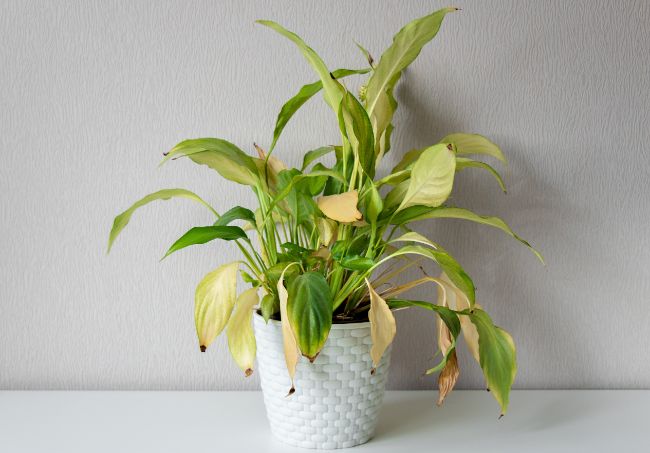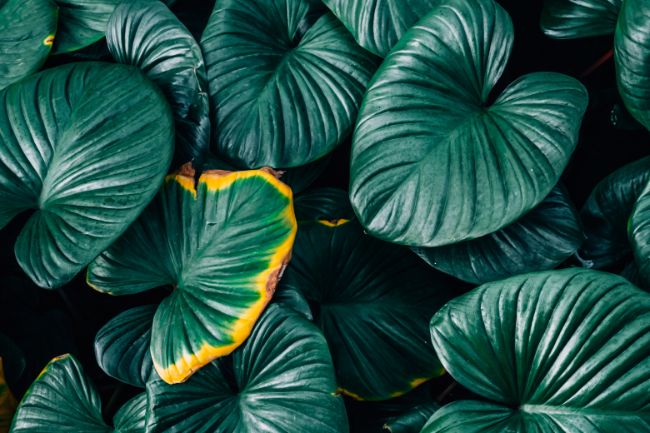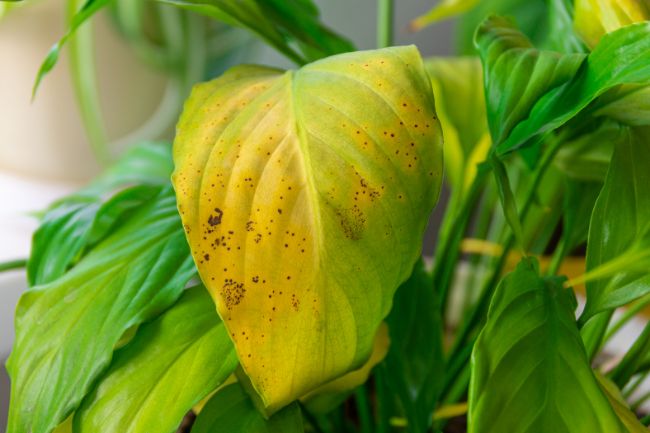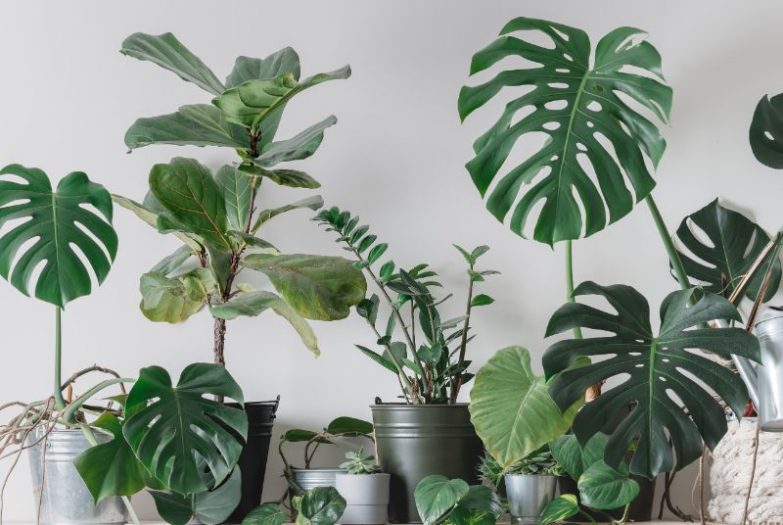Yellow leaves look nice on autumn trees … but not houseplants. Aging foliage turns yellow naturally, but otherwise, it’s typically a sign of distress. In this article, we’ll examine how to make yellow leaves turn green again, and the reasons why they turn yellow.
Yellow leaves are often a sign of stress, and it’s generally not possible for yellow leaves to turn green again. Poor watering and lighting are the most common reasons, but fertilizer problems, pests, disease, acclimatization, temperature extremes, or transplant shock are other potential causes.
Overview: Can Yellow Leaves Turn Green Again?
Once a leaf turns yellow, it’s generally a goner. Sometimes a leaf with a little discoloration caused by poor nutrition or mild stress will green up again if the problem is quickly addressed, but it’s best not to get your hopes up.
That doesn’t mean the plant is doomed, however – far from it. A few yellow leaves should be considered warning signals: if you address the issue, the plant can return to its former verdant glory.
What Causes Yellow Leaves?
Foliage contains quantities of chlorophyll, a chemical that reflects green light. (Green is actually the color plants don’t consume!) Chlorophyll is a vital element in photosynthesis; a leaf loses its green coloration when this process is interfered with and the chemical breaks down.
In fact, foliage doesn’t actually change colors – the yellow pigment was already present in the leaf. It was simply overwhelmed by the larger amounts of chlorophyll. When chlorophyll degrades, the remaining pigments show up.
Can I Remove Yellow Leaves?
Once a leaf has turned completely yellow, it’s no longer producing energy for the plant and can be discarded. If nature is allowed to take its course, the leaf will eventually dry up and fall off.
If you want to hurry things along for aesthetic reasons, gently tug the leaf to see if it is ready to detach. If the leaf resists, don’t tear it off! Instead, trim the leaf with scissors close to the stem.
Note: Sterilize the blades first by dipping them in isopropyl (rubbing) alcohol or by another effective method.
If there is only partial yellowing, you can cut off discolored portions to let the leaf continue being useful for a bit longer. If it seems your plant’s yellowing leaves could harbor pests or decay pathogens, however, it’s best to snip them off.
Causes Of Yellow Leaves
Aging Leaves
Your plant will naturally decommission older leaves as it grows. Leaves turn yellow as they are shut down and drained of chlorophyll.
The rate at which plants discard old leaves varies. Lower leaves are typically the most mature.
Some growers wait until the leaves are completely yellow before discarding them, but once an older leaf is heading for the exits it can be removed.
Overwatering
Overwatering is the most common stress-related reason for leaf yellowing. No one means to drown their plants, but we can accidentally kill them with kindness.
If this is the issue, you’ll likely see a number of leaves turning yellow at once.
Check the soil to see if it’s soggy below the surface. The roots can’t breathe if the soil is too wet, which means the leaves can’t get the nutrients and moisture they need to carry on photosynthesis.
It’s important to investigate overwatering because it may be a signal that conditions are conducive to root rot – which can kill your plant quickly.
If soggy soil is the culprit, you should obviously stop watering until it dries properly. Here are additional tips:
- Reduce the light slightly to ease the plant’s stress.
- Keep temperatures on the warm side of the plant’s preferred range.
- Assess the roots to make sure they are healthy, sweet-smelling, and firm. If you find rot, you’ll need to take action.
- If the soil is heavy and has poor drainage, consider gently repotting the plant in a well-draining mix.
- Increase air circulation.
- Help the soil dry more quickly by unpotting the plant and placing it on absorbent material like newspaper. (Don’t let the soil dry out completely.)
- Be especially careful to monitor the soil’s moisture until new growth signals a recovery.
The amount of damage done by overwatering is a big factor, but plants vary in how quickly they can recover. Some bounce back quickly, others languish and may never be the same. Read my guide to fixing overwatered houseplants to help fix this problem.
If the overwatering problem is caught early, then the yellow leaves may turn green again, but if the damage is significant, then these leaves will continue their demise. Restoration of appropriate watering will lead to new healthy foliage.

Underwatering
Wet soil suffocates roots and prevents leaves from receiving water, but so does overly dry conditions. Yellowing from lack of moisture isn’t usually something you have to guess about, however: if the soil is dry and the plant has wilted, you have a big clue.
Don’t simply pour water onto an ailing plant: watering an already overwatered specimen can be deadly. Since both overwatering and drought conditions can cause wilting and yellow leaves, you’ll need to check the soil and review your watering routine.
Water Quality Issues
Some plants are highly sensitive to minerals and toxins in the soil and can be affected by city tapwater that contains chlorine or chloramine. Salts from old fertilizer and mineralized deposits can accumulate in the soil, too. The stress can show up as yellow or burned leaves.
It’s a good practice to regularly flush the soil by letting extra water drain through the mix at watering time. It’s best to only use with dechlorinated water. If you suspect poor water quality is causing your leaves to turn yellow, consider switching to purified water or rainwater. Read this article to find out if you need to change the type of water you are using on your plants. .
Lighting
Either too much or too little light can cause yellow leaves. If the environmental conditions don’t make it clear, examine the leaves.
- Too much direct light dries out or scorches foliage;
- Leaves deprived of sufficient light will remain hydrated. Low light reduces photosynthesis and lowers the amount of chlorophyll in the leaf, but it doesn’t interfere with moisture transference.
Another indication of a low light problem is having yellowing on the side furthest from the light source. Read this article to make sure you get the lighting for your plants just right.
Nutrient Issues
Though it’s not the most common cause, nutrient deficiencies can cause leaf yellowing and deformities. Just be sure to check out other reasons before reaching for the fertilizer.
There is a chance to make yellow leaves turn green after treating for a nutritional deficiency, but don’t count on it. Instead, look forward to seeing new green leaves once the problem has been addressed.
Here are common deficiencies and their symptoms:
Nitrogen – Low nitrogen is seen more often than other deficiencies because the element is mobile and leaches out of the soil with watering. Insufficient nitrogen causes general leaf yellowing that starts with older leaves first.
Potassium – Lack of potassium typically turns the edges of older leaves yellow.
Magnesium – This deficiency can cause patches of yellow that spread from the center of the leaf outward. The veins tend to stay green. Older leaves are affected first.
Iron – This symptom shows up on younger leaves first, turning top foliage yellow with green veins.
Sulfur – Low sulfur turns young leaves yellow. It will spread to the rest of the foliage.
Overfertilization can also cause yellowing as some chemicals can interfere with the absorption of specific nutrients. For example, excessive calcium, copper, phosphorus, or zinc can interfere with iron absorption. Read my guide to fertilizing houseplants to help keep your plants thriving and looking great year after year.

pH Issues
pH issues are related to nutrient absorption and can indirectly contribute to leaf yellowing. Checking the plant’s preferred pH range and testing the soil can reveal if you’re within the correct parameters. (It can give you a reading on your nutrient levels, too.)
It’s easy to overcorrect, though. Using modest applications of soil sulfur to lower the pH or horticultural lime to lower the pH are good options. Flush the soil regularly to prevent a build-up of fertilizer salts that can cause pH issues.
Humidity
The stress of low humidity can cause yellowing and brown, dried edges on leaves. This won’t be a problem for every plant: some need higher humidity than others.
You can modestly raise humidity by grouping plants together or placing water trays nearby; a room humidifier offers a more definitive solution. Misting is not recommended, however: it can cause fungal issues, especially if your plant is already weakened.
Drafts And Temperature Extremes
Leaves often turn light yellow and fall off if the plant is exposed to cold temperatures or a draft. Being located in the path of an air conditioner is asking for trouble.
There isn’t much you can do about the leaf damage once it happens, but you can remedy the problem by sheltering the plant from drafts and keeping it at its preferred temperature range.
Rootbound Conditions
The foliage on rootbound plants can turn yellow if the roots are damaged, which restricts delivery of oxygen, moisture and nutrients to the leaves.
The solution is to repot the plant into a larger container. You can prune the roots if you want to keep the container or the pot the same size. Read this article to learn how to repot your houseplants without a hitch.
Transplant Shock
Ironically, repotting a plant with yellow leaves can actually compound the issue.
The best way to deal with transplant shock is to give the plant appropriate care while it quietly recovers. Don’t fertilize, water excessively, or move the plant from place to place.
After it acclimates, the plant will recover and produce green leaves again.

Pests And Disease
A pest or disease infestation can cause leaf damage, deformity and discoloration, but it’s usually not the uniform yellowing seen with other causes. Typically it shows up as localized yellowing, mottling or holes in the foliage.
It’s important to check your plant routinely for pests, because it’s much easier to successfully treat a mild infestation you’ve caught early. Keep in mind that stressed plants attract invaders, so other underlying issues could also cause the yellowing.
Keeping the plant healthy is the best way to prevent disease.
- Promptly remove infected leaves.
- Isolate the plant.
- Make sure your tools are sterile to avoid further contamination.
Leaf spot disease and other ailments can affect leaves with telltale discoloration. Yellow, spreading blotchy patches can indicate a viral infection – unfortunately, viral disease is usually incurable and requires safe disposal of infected plants.
Last Word
Unless you catch the problem at an early stage, you’re unlikely to make yellow leaves turn green again. Yellow leaves are usually a sign of stress, so you should take time to identify any care issues and resolve them. Overwatering and lighting problems are the most likely issues, so think about these first.
If you’d like to keep your houseplants thriving, respond to any problems with ease, and get more pleasure from growing plants in your home, check out my book, Houseplants Made Easy.

